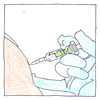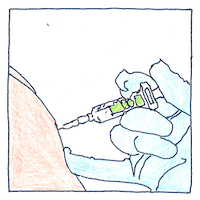Jean Joseph Henri Toussaint,
Louis Pasteur
immunology

|
Anthrax vaccine
Toussaint created the first live attenuated vaccine for chicken cholera, treating its agent, later named Pasteurella multocida to honor Pasteur, using carbolic acid, and in 1880 used the same method for creating a vaccine for anthrax. Pasteur began with Toussaint’s method, experimenting with chicken cholera, and used a similar method for creating a live attenuated anthrax vaccine, treating Bacillus anthracis with another antiseptic, potassium dichromate. * Publically, Pasteur claimed he treated the bacilli with oxygen; however, he used an antiseptic like Toussaint. The antiseptic, potassium dichromate, is an oxidizing agent. Some sources say there were problems with Toussaint’s vaccine; others say that Pasteur was jealous and greedy and should have given Toussaint credit.
Devastation
The fifth plague of Egypt, 1500 BCE, affecting horses, cows, sheep, oxen, and camels, and the sixth plague, the plague of boils, afflicting both man and beast, could both have been caused by Bacillus anthracis. In Homer’s Iliad, written in the eighth century BCE, Apollo’s punishment on the Achaeans, affecting pack animals, dogs, then soldiers, assuming Homer wrote of actual events, would have been anthrax. As the Huns swept across Eurasia in 80 A.D., forty thousand horses and a hundred thousand cattle died of anthrax. Multiple anthrax pandemics starting in 1613 known as the “black bane” killed sixty thousand cattle in Europe. Through the nineteenth century anthrax killed hundreds of thousands of horses, cows, sheep, goats, and people worldwide each year.
Economic incentive
Or “The story of an oxidizing agent.” This unacknowledged helper had already saved lives as an antiseptic. Little did one suspect it would be playing a leading role in an unrelated drama. The stakes were high. The government had tried to influence the scientific elite, but the relevant scientific facts were already known. The work remaining was more for technical assistants and veternarians. Was the work of a technical assistant stolen by the laboratory director? Was our agent’s role as an oxidizer deliberately obscured? Could a world-reknown scientist be working only for money? The gambit paid off. Plausible deniability had been carefully established. Even good agents under less pressure have been known to crack.



Today, live attenuated vaccines and dead inactivated vaccines compete, whether they are viral or bacterial. A live vaccine is cheaper and results in a more durable immunity, but is riskier; a dead vaccine is safer but requires multiple doses or boosters.
See also in The book of science:
Readings in wikipedia:
Other readings: